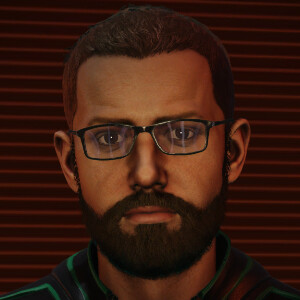Perseus Arm Expedition Log 16
01 Aug 2020Gkar_falcon
[Log started 01 0437 Z AUG 3306]I mapped Flyiedgue KC-Y c3-25 this morning, there were no significant geological features on any of the worlds, therefore once I had completed charting the system, I continued my journey.
I made forty-two jumps in the Woomera today. There were five systems that were significant enough for me to log, two of which were especially complex systems. There were no unusual geological sites today or notable stellar phenomena.
A few jumps after KC-Y c3-25 I arrived in Flyiedgue RO-U c5-7, my first notable system of the day. The A star had a metallic belt and was further orbited by two gas giants, one with water-based life, the other ammonia-based, and two class I gas giant. Each of these planets included their own complex system of moons. The B star started with a rocky belt, followed by a high metal content world, a water world, several rocky ice worlds, some icy bodies, and a class 1 gas giant with several moons.
The next system was eight jumps away, after a collection of stars, some of which had icy bodies and gas giants. Flyiedgue JO-L c10-21 was mostly commonplace; however, one of its two high metal content worlds was in the terraformable category. The rest of the planets were icy bodies.
It was a long stretch to the next system, and it was worth the wait. Flyiedgue FC-J b42-4 was the first of the especially complex systems I discovered today. It has three stars orbiting a barycentre, with a class I gas giant and high metal content world orbiting the three stars. Each of the stars and the gas giant have their own complex orbits, and the B and C stars have a high metal content world orbiting their own barycentre. The planets orbiting the B and C stars are small, not terraformable, high metal content worlds. Contrastingly, the five planets orbiting the A star are as large as Mars, and this orbit includes a terraformable water world.
The next system was a class M star and class T brown dwarf, then I jumped into Flyiedgue RO-Q c21-14. A great follow up system to FC-J b42-4, the three leading planets from this class K star were terraformable high metal content worlds, with the remaining planets being icy bodies.
Nine more systems and I arrive in my last noteworthy system for the day. Flyiedgue CZ-D d13-31, a class F star as primary with a class M secondary star, each with a complex orbit. The A star worlds comprising five high metal content worlds, two terraformable, and one gas giant with water-based life, while the B star has one metal rich body and seven high metal content worlds, three of which are terraformable. I intend to survey this system tomorrow, right now, I’m tired and overdue for some sleep.
[Log finished 01 1221 Z AUG 3306]
